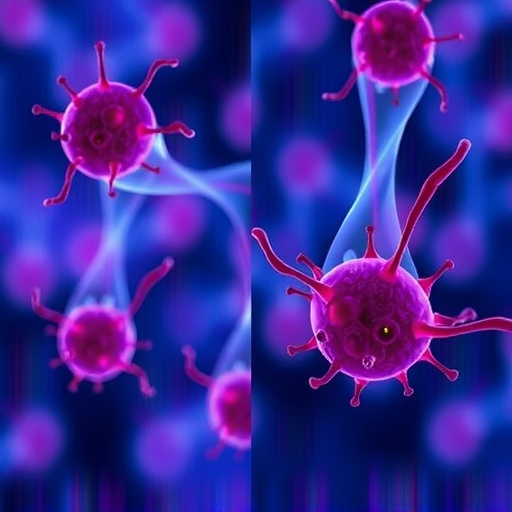In a groundbreaking study, researchers have uncovered the potential of esketamine in attenuating traumatic brain injury (TBI), offering new insights into therapeutic pathways that could reshape clinical approaches to managing this devastating condition. Traumatic brain injuries remain a significant public health concern, often leading to long-term neurological deficits. The study, published in BMC Neuroscience, draws attention to the neuroprotective effects of esketamine, a well-known NMDA receptor antagonist.
The significance of this research cannot be overstated. TBI frequently results in a cascade of metabolic disturbances and inflammatory responses that contribute to cell death and functional impairment. These pathophysiological changes often set the stage for secondary injuries that exacerbate the initial damage. By investigating the impact of esketamine on these processes, the researchers aimed to elucidate a novel pathway through which intervention may mitigate the harmful consequences of TBI.
One of the central themes of this study resides in the role of STAT3, a critical signaling molecule involved in various cellular functions, including survival, proliferation, and immune responses. The activation of STAT3 is particularly interesting, as it influences metabolic pathways, notably glycolysis, which is essential for generating energy in the brain. When the brain suffers an injury, energy deficits become pronounced, and any strategy that could enhance energy production is invaluable in protecting neural tissue. Esketamine’s ability to modulate STAT3 suggests a dual action: not only does it address energy metabolism, but it also engages immune pathways to prevent further neuronal damage.
The experimental methodology employed by Liu and colleagues reflects a rigorous approach to understanding the therapeutic effects of esketamine. Utilizing both in vitro and in vivo models, the researchers were able to assess the compound’s efficacy under controlled conditions that mimic the pathological environment of TBI. By analyzing key biomarkers associated with glycolysis and immune response, they were able to draw conclusions correlating esketamine treatment with improved recovery outcomes in these models.
What sets this research apart is its multifaceted approach. Instead of merely focusing on one aspect of TBI, the study examines the interaction between neuronal metabolism and immune modulation. This comprehensive analysis allows for greater insight into the mechanisms underlying brain injury and recovery. The results indicate that esketamine may play a role not only in preserving neuronal integrity but also in orchestrating an appropriate inflammatory response—crucial for healing processes.
The findings underscore the importance of advancing our understanding of pharmacological treatments for TBI beyond traditional interventions. As emphasized by the authors, most current therapies either focus on symptom management or address only a single pathway involved in TBI pathophysiology. Esketamine, with its capacity to engage multiple pathways, stands out as a potential candidate for clinical application in TBI management.
Neuroscience researchers have long sought better treatment options through innovative drug repurposing. By positioning esketamine within this context, Liu and colleagues contribute to a growing body of literature that adds substance to the notion of leveraging existing drugs in novel ways. The potential transition of esketamine from a psychiatric medication to a neuroprotective agent in TBI serves as a reminder of the versatility of pharmacological agents.
However, while the results are promising, the translation of these findings into clinical practice will require a careful and thorough approach. Future clinical trials will be essential to establish the safety and efficacy of esketamine for individuals with traumatic brain injuries. The journey from bench to bedside necessitates meticulous evaluation, considering factors such as timing of intervention, dosage, and potential side effects.
Additionally, the exploration of esketamine’s mechanisms of action paves the way for targeted therapies that could be tailored to patients’ specific needs based on their injury profiles. Understanding individual variability in response to esketamine treatment may help refine therapeutic strategies to maximize recovery outcomes for TBI victims.
As public interest grows in innovative approaches to TBI treatment, this study amplifies the dialogue surrounding neuropharmacology’s potential. The implications of esketamine in TBI open new avenues for discussion concerning existing therapeutic frameworks. Optimistically, future research could elucidate therapeutic windows and combination therapies that could further enhance outcomes.
Moreover, this research holds profound implications for health policy and resource allocation. As healthcare systems grapple with the increasing burden posed by brain injuries, efficacious and scalable treatments are urgently needed. The low cost of repurposed drugs like esketamine, if proven effective, could lead to substantial savings for healthcare systems while improving outcomes for patients.
In conclusion, the research conducted by Liu and colleagues marks an important milestone in the quest for effective therapies in traumatic brain injury management. Esketamine’s multifaceted interplay with STAT3-mediated glycolysis and immune responses presents a promising pathway that warrants further investigation. As neuroscientific inquiry continues to evolve, the hope remains that such innovative approaches will translate into real-world solutions, offering renewed hope to individuals affected by the debilitating effects of TBI.
Continued exploration in this domain is critical both for advancing scientific understanding and improving clinical outcomes for patients. If effectively translated into practice, esketamine could represent a new frontier in the treatment of traumatic brain injuries, emphasizing the potential benefits of repurposing existing medications to tackle complex neurological conditions.
Subject of Research: The potential of esketamine in attenuating traumatic brain injury through modulation of STAT3-mediated glycolysis and immune responses.
Article Title: Esketamine attenuates traumatic brain injury by modulating STAT3-mediated Glycolysis and immune responses.
Article References: Liu, Y., Gong, Z., Zhang, L. et al. Esketamine attenuates traumatic brain injury by modulating STAT3-mediated Glycolysis and immune responses. BMC Neurosci 26, 21 (2025). https://doi.org/10.1186/s12868-025-00941-z
Image Credits: AI Generated
DOI: https://doi.org/10.1186/s12868-025-00941-z
Keywords: Esketamine, traumatic brain injury, STAT3, glycolysis, immune response, neuroprotection, pharmacology, drug repurposing.
Tags: BMC Neuroscience study on esketaminecellular signaling in brain injuriesesketamine for traumatic brain injuryglycolysis and brain energy deficitsinflammatory responses in TBIlong-term neurological deficits after TBImetabolic disturbances in traumatic brain injuryneuroprotective effects of esketamineNMDA receptor antagonists in brain injurynovel therapeutic pathways for TBIsecondary injuries from traumatic brain injurySTAT3 modulation in TBI treatment





